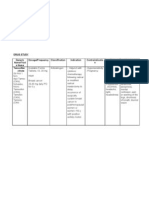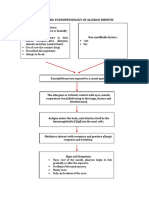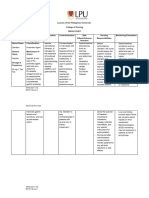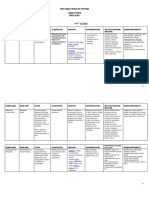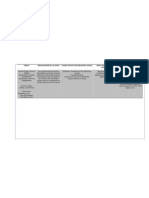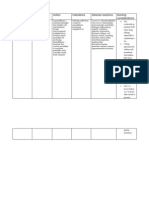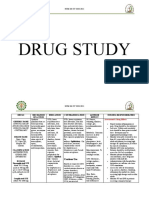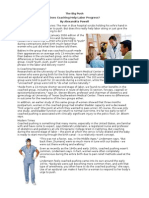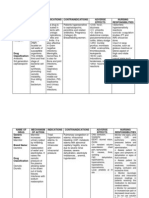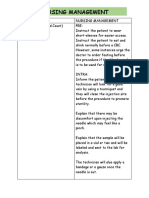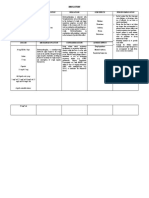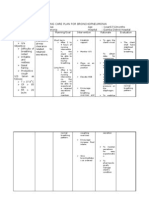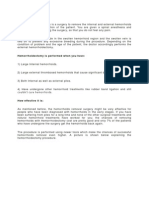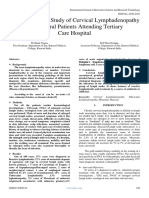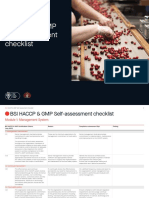Drug Study and NCP!
Drug Study and NCP!
Uploaded by
Abegail AbaygarCopyright:
Available Formats
Drug Study and NCP!
Drug Study and NCP!
Uploaded by
Abegail AbaygarOriginal Title
Copyright
Available Formats
Share this document
Did you find this document useful?
Is this content inappropriate?
Copyright:
Available Formats
Drug Study and NCP!
Drug Study and NCP!
Uploaded by
Abegail AbaygarCopyright:
Available Formats
ASSESSMENT
NURSING DIAGNOSIS
PLANNING
INTERVENTIONS
RATIONALE
EVALUATION
Subjective: Nahihirapan huminga si lola dahil sa plema, as verbalized by the patient relative. Objective: productive cough sputum is thick and brownish in color crackles DOB Deep breathing irritability
Ineffective Airway Clearance related to presence of Secretions secondary to Community acquired pneumonia
After 2 hours of nursing interventions, the clients respiration will improve and difficulty of breathing will be Relieved.
Monitor RR, taking note of the depth and rate, BP, PR Auscultate lung fields, noting presence of adventitious breath sounds Elevate head of bed to high fowlers
To establish baseline data and monitor changes To determine possible bronchospasm or obstruction To facilitate breathing and lung expansion To facilitate in the expulsion of mucus
After 2 hours of nursing intervention, goal was not met as evidenced by an increase in the depth and rate of respirations due to an increase in difficulty of breathing.
Provide health teachings regarding coughing and deep breathing exercise. Encourage client to increase fluid intake to about 2000 mL Administer medications such as expectorants as ordered
To liquefy secretions
To reduce bronchospasm and mobilize secretions
ASSESSMENT
NURSING DIAGNOSIS
PLANNING
INTERVENTIONS
RATIONALE
EVALUATION
Subjective : Nanghihina si lola as verbalized by the patient relative. Objective: Ineffective cough Restlessness Use of accessory muscles when breathing Loss of appetite Poor muscle tone
Imbalanced nutrition: less than body requirements related to inadequate intake of nutritious foods secondary to underlying disease as evidenced by loss of appetite and body weakness.
OBJECTIVE: After 5 hours of nursing intervention, the patient will regain body strength and loss of appetite will be relieved. GOAL: At the end of the nursing rotation, the patient will demonstrate behaviours, to regain or and or maintain appropriate weight.
Determine clients ability to chew, swallow, and taste food. Assess drug interactions, disease effects, allergies. Auscultate bowel sounds. Note characteristics of stool (color, amount, frequency etc.) Evaluate total daily food intake. Obtain diary of calorie intake, patterns and times of eating. Emphasize importance of well-balanced nutritious intake.
To determine factors that can affect ingestion and digestion of nutrients. To determine factors that may affect appetite, food intake or absorption. To evaluate degree of deficit
After 5 hours of nursing intervention, the patient regained body strength and loss of appetite has been relieved.
V/s
BP- 140/80 mm/Hg T -36.6 C P- 102 bpm R -41 cpm
To reveal possible cause of malnutrition/change s that could be made in clients intake. To promote wellness
ASSESSMENT
NURSING DIAGNOSIS
PLANNING
INTERVENTIONS
RATIONALE
EVALUATION
Subjective : none Objective: V/S BP: 140/80 mmHg T: 36.6 C P: 100 bpm R: 44 cpm With AB With ET DOB Restlessness Irritability
Impaired gas exchange related to ventilation perfusion imbalance.
After 8 hours of nursing intervention the patient will be able to: 1. Demonstrate improved ventilation and adequate oxygenation of tissues by HBGs within clients normal limits. 2. Participate in treatment regimen (e.g., breathing exercises, effective coughing, and use of oxygen) within level of ability/situation. 3. Verbalize understanding of causative factors and appropriate intervention.
Independent: 1. Elevated head of bed/position client appropriately, provide airway adjuncts and suction as indicated. 2. Encouraged frequent deep breathing/ coughing exercises. 3. Auscultated breath sounds noting crackles, wheezes
Independent: 1. To maintain airway
Goal -Met: After 8 hours of nursing intervention the patient was able to demonstrate improved ventilation and
2. Promotes optimal chest expansion and drainage of secretions.
adequate oxygenation of tissues by HBGs within clients normal limits.
3. Reveals presence of pulmonary congestion/ collection of secretion, indicating need for further intervention.
Collaborative: 1. Assisted with procedures as individually indicated (e.g., transfusion, phlebotomy, bronchoscopy.
Collaborative: 1. To improve respiratory function/ oxygen-carrying capacity.
Drug Name
Mechanism of Action
Indication
Contraindication
Side Effects/ Adverse Effects
Nursing Responsibilities
Brand Name: Salbutamol Generic Name : Albuterol Classification : Bronchodilator (respiratory smooth muscle relaxant), betaagonists.
Chemical Effect: Albuterol may reduce chemical mediator release from pulmonary mast cells and improve ability of cilia to clear mucus.
To relieve bronchospasm associated with acute or chronic asthma, bronchitis, or other reversible obstructive airway diseases. Also used to prevent exerciseinduced bronchospasm.
-Contraindicated in patients hypersensitive to drug or its ingredients. -Use cautiously in patients with CV disorders (including coronary insufficiency and hypertension), hyperthyroidism, or diabetes mellitus and in those who are unusually responsive to adrenergics. -Use extendedrelease tablets cautiously in patients with GI narrowing.
-CNS: tremor, nervousness, dizziness, insomnia, headache, hyperactivity, weakness, CNS stimulation, malaise. -CV: tachycardia, palpitations, hypertension. -EENT: dry and irritated nose and throat with inhaled form, nasal congestion, epistaxis, hoarseness. -GI: heartburn, nausea, vomiting, anorexia, altered taste, increased
-Drug may decrease sensitivity of spirometry used for diagnosis of asthma. -When switching patient from regular to extended-release tablets, remember that a regular 2-mg tablet every 6 hours is equivalent to an extendedrelease 4-mg tablet every 12 hours. -Syrup contains no alcohol or sugar and may be taken by children as young as age 2.
Therapeutic Effect: Albuterol is a direct-acting agent that relaxes smooth muscle walls of the bronchi, uterus, and skeletal muscle vascular bed.
appetite. -Metabolic: hypokalemia. -Musculoskeletal: muscle cramps. -Respiratory: bronchospasm, cough, wheezing, dyspnea, bronchitis, increased sputum. -Other: hypersensitivity reactions.
-In children, syrup may rarely cause erythema multiforme or Stevens-Johnson. -The HFA form uses the propellant hydrofluroalkane (HFA) instead of chlorofluorocarbon s. -Alert: Patient may use tablets and aerosol together. Monitor these patients closely for signs and symptoms of toxicity.
Drug Name
Mechanism of Action
Indication
Contraindication
Side Effects/ Adverse Effects
Nursing Responsibilities
Brand Name: Duphalac Generic Name : Lactulose Classification :
Drug passes unchanged into colon where bacteria breaks it down into organic acids that increase the osmotic pressure & slightly acidity colonic contents w/c increase stool softening action.
-constipation -prevention &treatment of portal-systemic encephalopathy
-low galactose diet -Intestinal obstruction
-Abdominal discomfort associated w/flatulence/cramps -prolonged use/large doses may result in diarrhea w/excessive loss of water & electrolytes.
-do not administer if pt. has already pass out stool-give laxative syrup w/ water, juice or milk to increase palatability -do not give other laxativesreplace fluid loss -monitor serum ammonia levels &blood glucose levels.
Drug Name
Mechanism of Action
Indication
Contraindication
Side Effects/ Adverse Effects
Nursing Responsibilities
Brand Name: Fluimucil Generic Name : Acetylcysteine Classification : Mucolytic Agent
-Nausea, rhinorrhea, bronchospasm especially in asthmatics, stomatitis, and urticaria.
-Mucolytic Adjuvant therapy for abnormal, viscid, or inspissated mucus secretion in acute and chronic broncho pulmonary disease (pneumonia, asthma, TB).
-Contraindicated with hypersensitivity to acetylcysteine; use caution and discontinue if bronchospasm occurs.
> Fever, drowsiness, tachycardia, hypotension, flushing, ear pain, eye pain, nausea, vomiting.
> Drug smell strongly of sulfur. Mixing oral form with juice or cola improve sits taste. >Monitor coughs type and frequency. >Warn patient that drug may have a foul taste or smell that some patients find distressing.
IX. DRUG STUDY X. NURSING CARE PLAN
You might also like
- Military Nursing ServiceDocument2 pagesMilitary Nursing Serviceharpal_abh100% (1)
- NCPDocument7 pagesNCPAbbie TantengcoNo ratings yet
- Revised NCP (Baiae)Document9 pagesRevised NCP (Baiae)Jennifer BactatNo ratings yet
- Drug StudyDocument1 pageDrug StudySheryll Anne MolartoNo ratings yet
- Assessment/ Cues Nursing Diagnosis Background Knowledge Goal and Objectives Nursing Interventions and Rationale EvaluationDocument6 pagesAssessment/ Cues Nursing Diagnosis Background Knowledge Goal and Objectives Nursing Interventions and Rationale EvaluationimnasNo ratings yet
- Health Teaching Plan DyspneaDocument3 pagesHealth Teaching Plan DyspneaMae JavierNo ratings yet
- Name of Drug Dosage, Route & Frequency Mechanism of Action Indication Contraindication Side-Effects Nursing ResponsibilitiesDocument5 pagesName of Drug Dosage, Route & Frequency Mechanism of Action Indication Contraindication Side-Effects Nursing ResponsibilitiesDivine Grace Arreglo AbingNo ratings yet
- CombiventDocument1 pageCombiventleroux2890No ratings yet
- CEFUROXIMEDocument2 pagesCEFUROXIMEMelvz BallesterosNo ratings yet
- Drug Study: San Francisco St. Butuan City 8600, Region XIII Caraga, PhilippinesDocument2 pagesDrug Study: San Francisco St. Butuan City 8600, Region XIII Caraga, PhilippinesNikki Caryl ZafraNo ratings yet
- Book-Based: Pathophysiology of Allergic RhinitisDocument2 pagesBook-Based: Pathophysiology of Allergic RhinitisJeraldine Corpuz PascualNo ratings yet
- IV. Physical AssessmentDocument7 pagesIV. Physical AssessmentJustene PeñamoraNo ratings yet
- NCM 110 Lec Act.1 Prelim VirayDocument4 pagesNCM 110 Lec Act.1 Prelim VirayJezzy VeeNo ratings yet
- Abruptio Placenta NCPDocument2 pagesAbruptio Placenta NCPjohncarlo ramos100% (1)
- Objectives PneumoniaDocument3 pagesObjectives PneumoniaYanna N. CuakiNo ratings yet
- LevemirDocument2 pagesLevemirViah Angela CaasiNo ratings yet
- GliclazideDocument5 pagesGliclazideGwyn RosalesNo ratings yet
- FINAL Drug StudyDocument2 pagesFINAL Drug StudycasedraftNo ratings yet
- DrugStudy Itopride (Ganaton)Document2 pagesDrugStudy Itopride (Ganaton)jean19.go100% (1)
- Drug Cefaclor IsoxsuprineDocument6 pagesDrug Cefaclor IsoxsuprineJelly Ong 王金玉No ratings yet
- Pharmacologic Class: Contraindications: CNS: Headache, BeforeDocument4 pagesPharmacologic Class: Contraindications: CNS: Headache, BeforeGwyn RosalesNo ratings yet
- Drug Study Drug Mechanism of Action/side Effects Indication/ Contraindication Nursing Responsibilities Brand NameDocument2 pagesDrug Study Drug Mechanism of Action/side Effects Indication/ Contraindication Nursing Responsibilities Brand NameDominic JoseNo ratings yet
- Asian College of Science and Technology College of Nursing Drug StudyDocument7 pagesAsian College of Science and Technology College of Nursing Drug StudynizabangxNo ratings yet
- NCP Pre EclampsiaDocument2 pagesNCP Pre EclampsiaFarrah Grace Birowa0% (1)
- DRUG Ferrous SulfateDocument1 pageDRUG Ferrous SulfateLovelaine Busto AlaguiaNo ratings yet
- OMEPRAZOLEDocument2 pagesOMEPRAZOLEkaye barrionNo ratings yet
- Acute Gastroentiritis (NCP)Document3 pagesAcute Gastroentiritis (NCP)April ParanganNo ratings yet
- OxacillinDocument2 pagesOxacillinSatinderSinghNo ratings yet
- DRUG STUDY (Appendicitis)Document14 pagesDRUG STUDY (Appendicitis)Jobelle AcenaNo ratings yet
- Drug Study Drug Name Mechanism of Action Dosage Indication Contraindication Side Effects Nursing InterventionsDocument5 pagesDrug Study Drug Name Mechanism of Action Dosage Indication Contraindication Side Effects Nursing InterventionsYvonne AgathaNo ratings yet
- NCP 1 1Document10 pagesNCP 1 1Samantha VeraNo ratings yet
- Article and Journal in Delivery RoomDocument3 pagesArticle and Journal in Delivery Roomcutei_annNo ratings yet
- Drug Study FinalDocument5 pagesDrug Study FinalJackie Ann Marie DapatNo ratings yet
- Drug Study 04-21-09Document2 pagesDrug Study 04-21-09obietobiNo ratings yet
- PCAP CPDocument14 pagesPCAP CPMikael R. SmileNo ratings yet
- PDF Albumin Drug StudyDocument1 pagePDF Albumin Drug StudyJamie John EsplanadaNo ratings yet
- DRUG STUDY (Diethystilbestrol)Document2 pagesDRUG STUDY (Diethystilbestrol)Avianna CalliopeNo ratings yet
- Nursing ManagementDocument19 pagesNursing ManagementAjie ZamNo ratings yet
- Drug Study (Acetaminophen)Document1 pageDrug Study (Acetaminophen)Kian HerreraNo ratings yet
- Discharge PlanDocument2 pagesDischarge Plankim arrojado100% (1)
- DRUG STUDY AtorvastatinDocument1 pageDRUG STUDY AtorvastatinKyla BeconiaNo ratings yet
- Cues Problem Physiologic Behavioral: Nutrition: Less Than Body Requirements Acute Pain Altered ADLDocument3 pagesCues Problem Physiologic Behavioral: Nutrition: Less Than Body Requirements Acute Pain Altered ADLAya BolinasNo ratings yet
- Drug Study SARAHDocument2 pagesDrug Study SARAHirene Joy DigaoNo ratings yet
- Drug Study of ChloramphenicolDocument3 pagesDrug Study of Chloramphenicolcasimir1128No ratings yet
- Acute GastroenteritisDocument2 pagesAcute GastroenteritisErika CadawanNo ratings yet
- Drug StudyDocument4 pagesDrug StudyAilah Mae Dela Cruz0% (1)
- DRUG STUDY (Dextromethorphan)Document2 pagesDRUG STUDY (Dextromethorphan)Avianna CalliopeNo ratings yet
- NCP DobDocument2 pagesNCP DobTata Wendz100% (1)
- TRAMADOLDocument4 pagesTRAMADOLRudie Lee PascualNo ratings yet
- CombiventDocument1 pageCombiventDherick Rosas0% (1)
- BPN NCPDocument6 pagesBPN NCPJoart EspinozaNo ratings yet
- UnasynDocument1 pageUnasynrachieeeNo ratings yet
- Clarithromycin Drug StudyDocument1 pageClarithromycin Drug StudyDivine LavaNo ratings yet
- NCP Ineffective Breathing ActualDocument3 pagesNCP Ineffective Breathing ActualArian May Marcos100% (1)
- Journal Pcap CDocument3 pagesJournal Pcap CKit Lara50% (2)
- CEFUROXIMEDocument1 pageCEFUROXIMEJose Luis HernandezNo ratings yet
- NCPDocument4 pagesNCPAbegail Abaygar100% (1)
- Nursing Management of COPDDocument6 pagesNursing Management of COPDZulyca JamalulNo ratings yet
- NCPsDocument13 pagesNCPsRocel DevillesNo ratings yet
- NCP'SDocument10 pagesNCP'SEjie Boy IsagaNo ratings yet
- Fdar NonieDocument3 pagesFdar NonieDana LabusonNo ratings yet
- Definition of TermsDocument2 pagesDefinition of TermsAbegail AbaygarNo ratings yet
- HemmorhoidectomyDocument3 pagesHemmorhoidectomyAbegail AbaygarNo ratings yet
- Nursing Care Plan !Document2 pagesNursing Care Plan !Abegail AbaygarNo ratings yet
- Concept Map - Abby !Document2 pagesConcept Map - Abby !Abegail AbaygarNo ratings yet
- NCPDocument4 pagesNCPAbegail Abaygar100% (1)
- NAME: - CLASS: - : Miss Sangavi'S Liveworksheet 16 August 2021, MondayDocument4 pagesNAME: - CLASS: - : Miss Sangavi'S Liveworksheet 16 August 2021, MondayMercedes Fernández Ramírez100% (1)
- Dr. Adrian Botan-Surgical and Conservative Treatment of Chronic Trophic UlcerDocument21 pagesDr. Adrian Botan-Surgical and Conservative Treatment of Chronic Trophic UlcerCezara AntonNo ratings yet
- Cardiac MonitoringDocument5 pagesCardiac MonitoringAmit Kl100% (1)
- Etiopathological Study of Cervical Lymphadenopathy in 100 Rural Patients Attending Tertiary Care HospitalDocument5 pagesEtiopathological Study of Cervical Lymphadenopathy in 100 Rural Patients Attending Tertiary Care HospitalInternational Journal of Innovative Science and Research TechnologyNo ratings yet
- Task "Dialogue Health Teaching" Monday, September 21, 2020: SituationDocument2 pagesTask "Dialogue Health Teaching" Monday, September 21, 2020: SituationAnisa KartikaNo ratings yet
- Case Study Assessing Thorax and LungsDocument4 pagesCase Study Assessing Thorax and LungsMaurice CudalNo ratings yet
- UNAIDS FactSheet enDocument6 pagesUNAIDS FactSheet enTatamo LalaNo ratings yet
- Job Scientific Project Manager ERN EYEDocument3 pagesJob Scientific Project Manager ERN EYEJS57No ratings yet
- HACCP and GMP Self Assessment ChecklistDocument48 pagesHACCP and GMP Self Assessment ChecklistMin ThuraNo ratings yet
- DK Kzy FPFDRLK VF/KDKJH Izhkkjh Izkfkfed Loklf Dsunz Eksmd Xkao Ftyk DKSVK JKTDocument8 pagesDK Kzy FPFDRLK VF/KDKJH Izhkkjh Izkfkfed Loklf Dsunz Eksmd Xkao Ftyk DKSVK JKTJigneshvyas1No ratings yet
- Water Supply in NepalDocument4 pagesWater Supply in NepalSamita sharmaNo ratings yet
- Call For Abstracts 2nd National CSS Knowledge Dissemination Forum FinaleDocument5 pagesCall For Abstracts 2nd National CSS Knowledge Dissemination Forum FinaleMark OdhiamboNo ratings yet
- Free Guided Meditations Brainwave Therapy - BraDocument1 pageFree Guided Meditations Brainwave Therapy - BrasusheelsoftskillsNo ratings yet
- Establishing and Maintaining A Dental OfficeDocument17 pagesEstablishing and Maintaining A Dental OfficeMinnuNo ratings yet
- Bimonthly English Evaluation. 4 Term. 9 GradeDocument5 pagesBimonthly English Evaluation. 4 Term. 9 GradeCarolina CechtNo ratings yet
- DANISH INSTITUTE OF NURSING & ALLIED HEALTH SCIENCES PPTDocument35 pagesDANISH INSTITUTE OF NURSING & ALLIED HEALTH SCIENCES PPTayzel.interNo ratings yet
- Validation of Moca Test in Vietnamese Language For Cognitive Impairment ScreeningDocument17 pagesValidation of Moca Test in Vietnamese Language For Cognitive Impairment ScreeningMolly Dang100% (1)
- Green Carts - Get The FactsDocument3 pagesGreen Carts - Get The FactsStreet Vendor ProjectNo ratings yet
- Dog FoodDocument33 pagesDog FoodAnkeeta DebNo ratings yet
- HND 309 Nutrition SurveillanceDocument6 pagesHND 309 Nutrition Surveillancehafeesadetunji01No ratings yet
- Almart King L. Suhaili BSMT 1 - E PATHFIT Exit AssessmentDocument10 pagesAlmart King L. Suhaili BSMT 1 - E PATHFIT Exit AssessmentAlmart King SuhailiNo ratings yet
- Cranial NeurosurgeryDocument61 pagesCranial NeurosurgeryMikeNo ratings yet
- Andrea Nakayama Hashimotos Institute 9-15-2014Document35 pagesAndrea Nakayama Hashimotos Institute 9-15-2014Vivek GuptaNo ratings yet
- Senior Project Paper FinalDocument5 pagesSenior Project Paper Finalapi-281742815No ratings yet
- G6PD Triggers and The Response of The Human BodyDocument4 pagesG6PD Triggers and The Response of The Human BodylepetityoshiNo ratings yet
- SDDC JPR AdvertisementDocument3 pagesSDDC JPR Advertisementhemant singhNo ratings yet
- Stress Inoculation TrainingDocument17 pagesStress Inoculation Trainingumibrahim100% (1)
- How To Read The Barometer of Concern:: 2-5-Year-Old ChildrenDocument2 pagesHow To Read The Barometer of Concern:: 2-5-Year-Old ChildrenevaghencheNo ratings yet
- RESUS 8904 Special CircsDocument68 pagesRESUS 8904 Special CircsCroBranNo ratings yet



